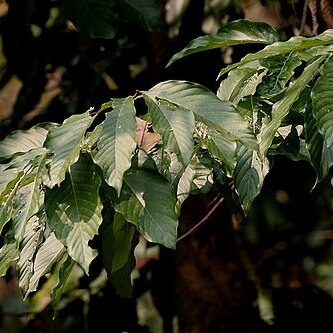Deciduous trees to 15 m tall, to 1 m d.b.h. Bark smooth, gray, exfoliating; branchlets glabrous, stout. Petiole 2-5 cm, glabrous, with narrow wings; leaf blade oblong to obovate-oblong, 20-60 × 10-25 cm, leathery, secondary veins 25-50 on either side, margin with shallowly undulate teeth. Flowers 2-7, small, fascicled at top of lateral spurs, 2-3 cm in diam., less than 2 cm in diam. in bud; pedicels 2-4 cm, bractlets deciduous. Sepals 5. Petals 5, yellow, obovate. Stamens in 2 distinct groups, outer 60-90, 3-4 mm, slightly curved in bud, inner ca. 10, reflexed, 6-9 mm; anthers dehiscing with longitudinal slits. Carpels 5 or 6, 3.5-4 mm in diam.; stylodia spreading; ovules 5-20 per carpel. Pseudocarp indehiscent, yellow, orange, or red; carpels each 1(or 2)-seeded. Seeds exarillate. Fl. Apr-May.
A tree. It grows 6-17 m tall. The twigs are twisted. The bark is grey and smooth. The leaves are large and 35-53 cm long by 12-30 cm wide. They fall off during the year. The leaves narrow to the base and have teeth along the edge. The flowers appear before the leaves. The flowers are yellow. The fruit are round. The fruit is succulent.

